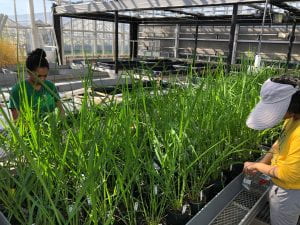Rice is a staple crop among the Sa’amaka Maroons of Suriname, a culturally, politically, and economically independent people from the upper Suriname River. Rice cultivation and consumption are intimately linked to Sa’amaka cultural identity and oral history dating back to the escape from slavery in the 17th century. Traditional rice cultivation is under threat from a variety of environmental and socio-economic factors, including land degradation, increasing consumption of commodity rice bought in the capital, and loss of rice-growing knowledge. Previous reports have suggested that the Sa’amaka grow both Asian rice (Oryza sativa) and its African relative (O. glaberrima), but few Sa’amaka rice varieties have been studied at the genetic level.
Supported by Atkinson Foundation Venture Research Fund award, Erika Styger (IP-CALS faculty) and Rosy Glos (CALS plant science major) traveled to Suriname to collect samples of rice grown by traditional farmers in 17 field sites along the Suriname River, and were given permission to bring seeds back to Cornell University through a formal agreement with the village chief and elders.
Together Susan McCouch, Sandra Harrington, Margaret Royal and team of undergraduates including Iriel Edwards and Yuna Seo, we grew from seed and resequenced a total of 432 lines. We are using the resulting dataset to investigate the extent of genomic diversity and to address four initial questions: 1) Are Sa’amaka varieties maintained as pure lines or as heterogeneous populations? 2) Do variety names identify the same genetic entities in different farmers’ fields? 3) Is there any evidence of hybridization or admixture resulting from intentional cross pollination? 4) What is the interplay between geographic distribution of field sites and genetic diversity of Saamaka rice varieties?
The dataset generated as part of this collaborative project provides the most comprehensive view of rice diversity managed by traditional farmers anywhere in the Guianas. Results were presented by lead postdoc Dr. Jacob Landis at Plant and Animal Genomes (PAG) 2020.
Iriel Edwards dehulling rice collected in Suriname (right). Rice growing and being tended in the Gutterman Greenhouses (left).



